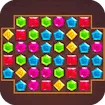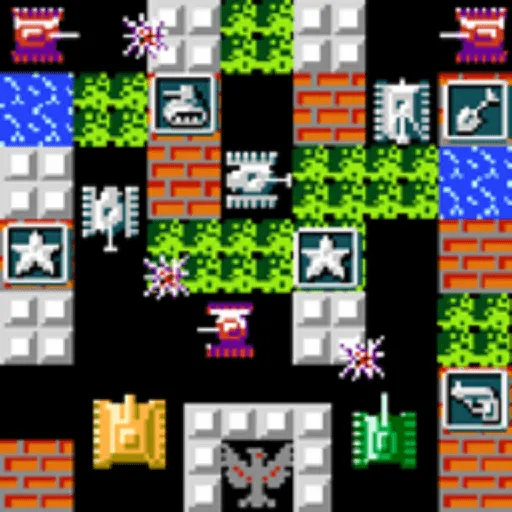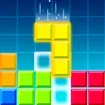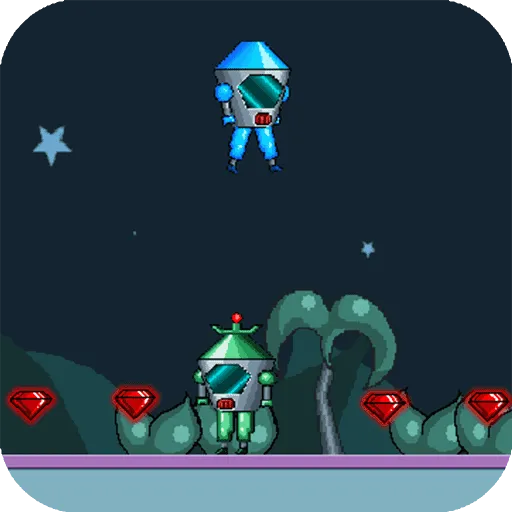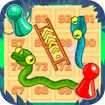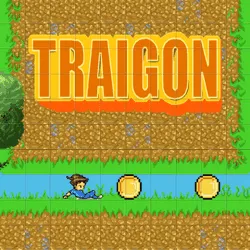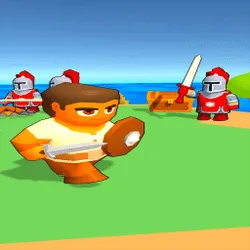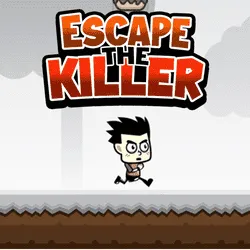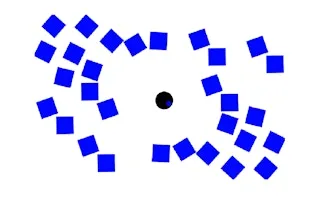Falling Blocks - Tetris Game Instructions
Start the Game: Begin by pressing the play button. Blocks (called Tetriminos) will start falling from the top of the screen.
Move the Blocks: Use the left and right arrow keys to move the falling block sideways. Adjust its position to fit it into empty spaces.
Rotate the Block: Press the up arrow key to rotate the block. This helps fit different shapes into gaps and create full lines.
Drop the Block Quickly: Use the down arrow key to make the block drop faster, speeding up gameplay when you know where it should go.
Clear Lines for Points: Arrange the blocks to fill entire horizontal rows. When a row is complete, it disappears, giving you points and creating more space to keep playing.
Prevent Blocks from Stacking Up: Keep the blocks from reaching the top of the screen. If they stack too high, the game will end.
Use the Hold Feature (if available): You can save a block for later by pressing the hold button. This strategy helps when waiting for a specific piece to complete a line.
title="YouTube video player"
frameborder="0"
allow="accelerometer; autoplay; clipboard-write; encrypted-media; gyroscope; picture-in-picture; web-share"
referrerpolicy="strict-origin-when-cross-origin"
allowfullscreen>
Tip: Practice rotating and positioning blocks quickly. The speed of the blocks will increase over time, so stay alert!
Move the Blocks: Use the left and right arrow keys to move the falling block sideways. Adjust its position to fit it into empty spaces.
Rotate the Block: Press the up arrow key to rotate the block. This helps fit different shapes into gaps and create full lines.
Drop the Block Quickly: Use the down arrow key to make the block drop faster, speeding up gameplay when you know where it should go.
Clear Lines for Points: Arrange the blocks to fill entire horizontal rows. When a row is complete, it disappears, giving you points and creating more space to keep playing.
Prevent Blocks from Stacking Up: Keep the blocks from reaching the top of the screen. If they stack too high, the game will end.
Use the Hold Feature (if available): You can save a block for later by pressing the hold button. This strategy helps when waiting for a specific piece to complete a line.
Falling Blocks - Tetris Video Game Demo
title="YouTube video player"
frameborder="0"
allow="accelerometer; autoplay; clipboard-write; encrypted-media; gyroscope; picture-in-picture; web-share"
referrerpolicy="strict-origin-when-cross-origin"
allowfullscreen>
Tip: Practice rotating and positioning blocks quickly. The speed of the blocks will increase over time, so stay alert!
Categories:
Falling Blocks - Tetris Game Description
Falling Blocks - Tetris: The Timeless Block Puzzle Game
Experience the classic thrill of "Falling Blocks - Tetris" on PunyGame, where players dive into the iconic challenge of stacking Tetriminos to clear lines and set new high scores. Learn tips, strategies, and more in this in-depth look at a game that continues to captivate puzzle lovers worldwide.
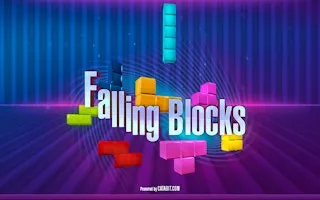
Falling Blocks - Tetris
The Origins of Tetris: How "Falling Blocks" Became a Global Phenomenon
"Falling Blocks - Tetris" holds a unique position in gaming history as both a highly addictive puzzle game and a cultural icon. Originally created by Russian software engineer Alexey Pajitnov in 1984, Tetris was a simple idea with powerful appeal: arrange falling blocks (Tetriminos) into complete rows to score points and prevent the stack from reaching the top. This concept quickly resonated worldwide, becoming the definitive block-stacking puzzle game. Tetris's minimalistic design, combined with its challenging mechanics, has inspired countless versions, adaptations, and competitions.
The core gameplay of "Falling Blocks - Tetris" involves arranging various Tetrimino shapes—L-shapes, T-shapes, squares, and lines—that fall from the top of the screen at increasing speeds. Players must quickly place these blocks to create horizontal lines, clearing space and preventing the stack from reaching the top. While it sounds simple, the beauty of Tetris lies in its complexity and the need for strategic thinking under pressure. Whether you’re a beginner learning the basics or an experienced player aiming for high scores, Tetris has something to offer everyone.
Understanding the Gameplay Mechanics: Strategies for Stacking Success
The gameplay in Tetris is deceptively straightforward but requires skill, timing, and a deep understanding of block mechanics to excel. Tetris's unique appeal comes from its learning curve: while anyone can pick it up and start playing, mastering it demands time and dedication. Knowing the block types, or Tetriminos, is essential for improving performance and achieving high scores. Each Tetrimino has a different shape and behaves uniquely when rotated and placed on the board.
In classic Tetris, players use strategies like "Tetris stacking," where a single column is left open to drop the long I-shaped piece for maximum points. Advanced players often rely on techniques like "T-spins" to clear blocks in tight spaces. Additionally, maintaining a "flat" stack without excessive peaks ensures that the game progresses smoothly, giving players more room to maneuver and make strategic moves. Mastering these techniques takes time, but they are essential for high-level gameplay and can significantly improve your scores.
The "Tetris Effect": The Psychology Behind Falling Blocks
One fascinating aspect of Tetris is the "Tetris effect," a phenomenon where players visualize falling blocks in their minds even when they’re not actively playing. This effect is so pronounced that Tetris has become a subject of study in psychology and cognitive science. Researchers have found that playing Tetris can help improve spatial awareness, visual memory, and even problem-solving skills. This cognitive benefit, coupled with the game’s inherent entertainment value, makes Tetris more than just a game; it’s a mental exercise.
Many players report that Tetris helps them develop focus and mental agility, making it a perfect game for those looking to challenge their minds while having fun. Playing Tetris has also been shown to help reduce stress, as the concentration required can lead to a meditative flow state. The game’s repetitive and rhythmic nature allows players to immerse themselves in the process, focusing solely on the immediate task at hand—placing the next block. This combination of engagement and mental exercise has helped Tetris remain popular for decades.
Modern Adaptations and Popularity: Tetris in the Digital Age
With its enduring appeal, Tetris has seen numerous adaptations and updates for modern audiences. "Falling Blocks - Tetris" can be found on various platforms, including online gaming sites like PunyGame, where players can enjoy the game without the need for downloads. In recent years, Tetris has also ventured into multiplayer formats, adding a new layer of competition. Games like "Tetris 99" introduce battle royale elements, where players compete against others in real-time, aiming to be the last one standing. This adaptation appeals to new generations of gamers, proving that Tetris can remain relevant in a rapidly evolving gaming landscape.
Another popular adaptation, "Tetris Effect," incorporates immersive soundscapes and visuals, enhancing the classic gameplay with a modern, meditative twist. These innovations demonstrate the versatility of Tetris’s core mechanics, which can adapt to various gameplay styles without losing their essence. The widespread availability of Tetris across consoles, mobile devices, and online platforms makes it accessible to players of all ages, further cementing its status as a universal game.
The Cognitive Benefits of Playing Tetris: Beyond Entertainment
Tetris is more than just an entertaining game; it also offers substantial cognitive benefits. Studies have shown that playing Tetris regularly can improve spatial reasoning, a skill useful in fields like engineering, architecture, and even everyday tasks like packing or organizing spaces. The game’s requirement to visualize and rotate shapes in real-time helps strengthen the brain’s ability to process spatial information quickly and efficiently.
Playing Tetris can also aid in the development of problem-solving skills. The constant challenge of fitting irregular shapes into a confined space forces players to think critically and adapt to changing circumstances. This mental flexibility is a valuable skill in both personal and professional contexts. Additionally, the fast-paced nature of Tetris can enhance hand-eye coordination and reaction time, as players must make quick decisions under pressure. These cognitive benefits make Tetris not only enjoyable but also beneficial for mental development.
Tetris as a Cultural Icon: The Legacy of Falling Blocks
Since its creation, Tetris has become an icon of pop culture, with references appearing in music, movies, art, and even fashion. The game’s simple yet challenging mechanics resonate universally, appealing to people of all ages and backgrounds. Its distinctive block shapes and catchy theme music are instantly recognizable, even to those who have never played the game. Tetris’s impact extends beyond gaming; it symbolizes the appeal of simplicity in design and the beauty of a well-executed concept.
Tetris has inspired numerous cultural references, from the iconic Tetris theme music to visual art that mimics the falling blocks. The game’s influence can be seen in various forms of media, where its imagery and themes are used to convey ideas of order, chaos, and control. This cultural significance, combined with its addictive gameplay, has made Tetris a game that transcends generations. Tetris’s legacy continues as new generations of players discover and enjoy this timeless classic.
Competitive Tetris and the Online Community: A Global Fanbase
The Tetris community is a passionate and dedicated fanbase that has grown significantly over the years. Tetris competitions, such as the Classic Tetris World Championship, attract top players from around the world, showcasing impressive skills and intense matches. These competitions highlight the strategic depth of Tetris, proving that the game requires more than quick reflexes; it demands a deep understanding of the mechanics and the ability to remain calm under pressure.
Online platforms and forums, such as Reddit’s r/Tetris, provide a space for players to share tips, strategies, and high scores. Social media channels also allow Tetris enthusiasts to connect and celebrate the game’s enduring appeal. This active community has helped Tetris remain a relevant and exciting game, even decades after its original release. Whether through competitions or casual gameplay, the Tetris community continues to grow, fostering a shared love for this iconic puzzle game.
Tips and Strategies for New Players: Mastering Falling Blocks
For those new to "Falling Blocks - Tetris," mastering the basics can make the game more enjoyable and rewarding. One of the first things to learn is how to create "Tetrises," where four lines are cleared at once using the I-shaped Tetrimino. This move is essential for maximizing points and creating space on the board. Another important strategy is to keep the stack as flat as possible, avoiding peaks that can lead to difficult placements.
Learning to rotate and position each Tetrimino quickly is crucial, as the game’s speed increases over time. Practicing rotations and understanding each shape’s fit on the board will make gameplay smoother and help prevent gaps. Additionally, using the "hold" function, available in many modern versions of Tetris, allows players to save a piece for later use, adding a layer of strategy to the game. These tips provide a solid foundation for beginners, setting them on the path to becoming skilled Tetris players.
"Falling Blocks - Tetris" on PunyGame offers a modern twist on this classic game, allowing players to enjoy the challenge of Tetris in an accessible online format. With practice, players can master these strategies and experience the unique satisfaction of clearing lines and setting high scores.
PunyGame © 2022. All rights reserved.

